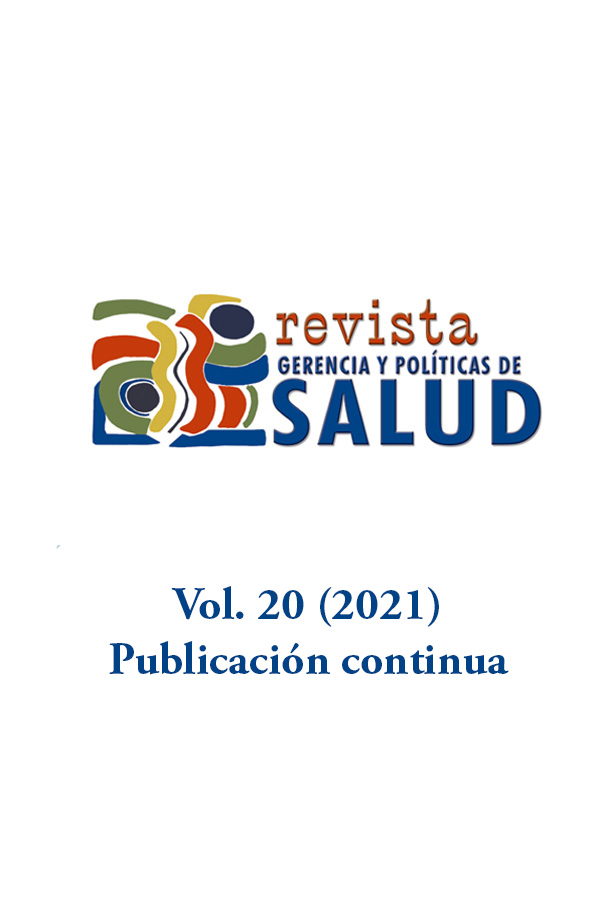Resumo
Introdução. A pandemia da COVID-19 exerceu uma pressão sem precedentes sobre os sistemas de saúde, destacando as desigualdades em todo o mundo. Uma das preocupações durante esta situação tem sido a possível desigualdade no acesso aos exames diagnósticos, relacionada aos recursos econômicos da população. Neste estudo, foram analisados os resultados dos testes de detecção da COVID-19 em Bogotá e sua associação com o nível de renda. Métodos. Foi realizado um estudo ecológico com os relatórios do SIVIGILA, entre 6 de março e 1º de julho de 2020, para os registros com testes positivos e negativos para COVID-19. Foi realizada estatística descritiva com as variáveis quantitativas e qualitativas, assim como uma análise bivariada e adicionalmente foi calculado o coeficiente de Gini a partir da curva de Lorenz. Resultados. A análise incluiu 44.300 registros. Os testes foram realizados principalmente em homens (51,4%) e nos estratos mais elevados: 4, 5 e 6 (53,5%). Da mesma forma, o coeficiente de Gini evidenciou a desigualdade no acesso em relação aos estratos socioeconômicos. Conclusão. A análise mostrou desigualdade no acesso aos exames diagnósticos do SARS-CoV-2, onde os estratos mais altos tiveram mais acesso, associado a maior poder aquisitivo.
Kawachi I, Subramanian SV, Almeida-Filho N. A glossary for health inequalities. J Epidemiol Community Health. 2002;56(9):647-652. http://dx.doi.org/10.1136/jech.56.9.647
Wilder-Smith A, Freedman DO. Isolation, quarantine, social distancing and community containment: pivotal role for old-style public health measures in the novel coronavirus (2019-nCoV) outbreak. J Travel Med. 2020;27(2). https://academic.oup.com/jtm/article/27/2/taaa020/5735321
Irlacher M, Koch M. Working from home, wages, and regional inequality in the light of COVID-19. Rochester, NY: Social Science Research Network; 2020. Report No. ID 3582329. https://papers.ssrn.com/abstract=3582329
Beaunoyer E, Dupéré S, Guitton MJ. COVID-19 and digital inequalities: Reciprocal impacts and mitigation strategies. Comput Hum Behav. 2020;111:106424. https://doi.org/10.1016/j.chb.2020.106424
Bowleg L. We’re not all in this together: On COVID-19, intersectionality, and structural inequality. Am J Public Health. 2020;110(7):917. https://ajph.aphapublications.org/doi/full/10.2105/AJPH.2020.305766
Long run consequences of the COVID-19 pandemic on social inequality. UNDP. https://www.latinamerica.undp.org/content/rblac/en/home/blog/2020/consecuencias-de-la-pandemia-del-covid-19-en-las-desigualdades-s.html
Krieger N. Theories for social epidemiology in the 21st century: An ecosocial perspective. Int J Epidemiol. 2001;30(4):668-677. https://ibs.colorado.edu/jessor/psych7536-805/readings/krieger-2001_TheoriesforSocialEpidemiology.pdf
Nel P, Righarts M. Natural Disasters and the Risk of Violent Civil Conflict. Int Stud Q. 2008;52(1):159-185. https://www.jstor.org/stable/29734228?seq=1
Ahmed F, Ahmed N, Pissarides C, Stiglitz J. Why inequality could spread COVID-19. Lancet Public Health. 2020;5(5):e240. https://doi.org/10.1016/S2468-2667(20)30085-2
Abbasi K. Health inequalities: death by political means. BMJ. 2020;368. https://www.bmj.com/content/368/bmj.m755
Rodríguez Hernández JM. Aspectos sociales que pueden incidir en la pandemia. El rol de la salud pública y la epidemiología. Rev Univ Ind Santander. 2020;52:181-182. https://revistas.uis.edu.co/index.php/revistasaluduis/article/view/10935
Comisión Económica para América Latina y el Caribe-CEPAL. El desafío social en tiempos del COVID-19. 2020. https://www.cepal.org/es/publicaciones/45527-desafio-social-tiempos-covid-19
Mejia-Lancheros C, Lachaud J. Addressing social determinants of health: Reopen the debate and the implications for the health and overall well-being of Colombian people. Av En Enferm. 2020;38(2):135-139. https://doi.org/10.15446/av.enferm.v38n2.85241
Nuevo coronavirus 2019. https://www.who.int/es/emergencies/diseases/novel-coronavirus-2019
Dorn A van, Cooney RE, Sabin ML. COVID-19 exacerbating inequalities in the US. Lancet Lond Engl. 2020;395(10232):1243-1244. https://doi.org/10.1016/S0140-6736(20)30893-X
Coronavirus (COVID-19) Testing - Statistics and Research. Our World in Data. https://ourworldindata.org/coronavirus-testing
Coronavirus Colombia. https://www.ins.gov.co/Noticias/Paginas/Coronavirus.aspx
Regidor E. Measures of health inequalities: Part 1. J Epidemiol Community Health. 2004;58(10):858-861. https://doi.org/10.1136/jech.2003.015347
DANE. Gran Encuesta Integrada de Hogares (GEIH) 2019. Bogotá D.C.: DANE. http://microdatos.dane.gov.co/index.php/catalog/599/get_microdata
Suarez-Alvarez MM, Pham D-T, Prostov MY, Prostov YI. Statistical approach to normalization of feature vectors and clustering of mixed datasets. Proc R Soc Math Phys Eng Sci. 2012;468(2145):2630-2651. https://royalsocietypublishing.org/doi/10.1098/rspa.2011.0704
DANE. Encuesta Multipropósito (EM) 2014. Bogotá D.C.: DANE. https://www.dane.gov.co/index.php/estadisticas-por-tema/pobreza-y-condiciones-de-vida/encuesta-multiproposito/encuesta-multiproposito-2014#:~:text=La%20Encuesta%20Multiprop%C3%B3sito%20incluye%20los,de%20Bogot%C3%A1%20para%20el%202014.
Thomsen JL. Methods for analysing recurrent events in health care data. Examples from admissions in Ebeltoft Health Promotion Project. Fam Pract. 2006;23(4):407-413. https://academic.oup.com/fampra/article-lookup/doi/10.1093/fampra/cml012
Schneider MC, Castillo-Salgado C, Bacallao J, Loyola E, Mujica OJ et al. Métodos de medición de las desigualdades de salud. Rev Panam Salud Pública. 2002;12:398-414. https://www.scielosp.org/article/rpsp/2002.v12n6/398-414/es/
Arcaya MC, Arcaya AL, Subramanian SV. Inequalities in health: definitions, concepts, and theories. Glob Health Action. 2015;8(1):27106. https://doi.org/10.3402/gha.v8.27106
Krouse HJ. COVID-19 and the widening gap in health inequity. Otolaryngol Neck Surg. 5 de mayo de 2020; https://journals.sagepub.com/doi/10.1177/0194599820926463?url_ver=Z39.88-2003&rfr_id=ori%3Arid%3Acrossref.org&rfr_dat=cr_pub++0pubmed
Patel JA, Nielsen FBH, Badiani AA, Assi S, Unadkat VA, Patel B, et al. Poverty, inequality and COVID-19: the forgotten vulnerable. Public Health. 2020;183:110-111. https://doi.org/10.1016/j.puhe.2020.05.006
Schmitt-Grohé S, Teoh K, Uribe M. COVID-19: Testing inequality in New York City. 2020.
Smith JA, Judd J. COVID-19: Vulnerability and the power of privilege in a pandemic. Health Promot J Austr. 2020;31(2):158-160. https://doi.org/10.1002/hpja.333
Kristen JA, Zijun S, Romanelli R, Lockhart S, Smits K et al. Disparities In outcomes among COVID-19 patients in a large health care system in Californ. Health Aff (Millwood). 2020;39(7):1253-1262. https://doi.org/10.1377/hlthaff.2020.00598

Este trabalho está licenciado sob uma licença Creative Commons Attribution 4.0 International License.
Copyright (c) 2022 Jeadran Nevardo Malagón-Rojas, Edgar Antonio Ibáñez Pinilla, Yesith Guillermo Toloza Pérez, Eliana Téllez, Julia Almentero, Eliana Parra, Luisa Lagos, Diana Walteros, Marcela Mercado


